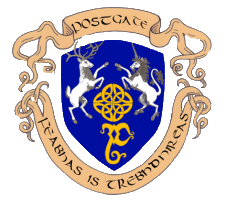Scottish Luckenbooth diamond pendant in 14K gold
Scottish Luckenbooth pendant, Pendants, as well as brooches and rings, are pieces that Suzan and I have enjoyed creating for many years. Our Scottish Luckenbooth diamond pendant is a nicely detailed version That was designed and made by George.
Scottish Luckenbooth diamond pendant in 14K gold Details:
The pendant is made of 14K gold. I've done my best to make a nice version of the Scottish crown. The design below the crown is of two intertwined abstract hearts. The pendant is set with six small brilliant cut high quality diamonds. I usually have a stone set in the middle of the hearts as well as hang the piece from a more elaborate bale, but this just felt right. You may order this pendant in two colors of gold and with different stones as a custom order. The stones are F-H in color and VS2 in clarity. This pendant is 1 1/2 " X 5/8ths inches. The chain is in 18K which is why the color is so different. You may order a 14K one in most lengths.
More Luckenbooths:
Please follow this link to see more of our Scottish jewelry:
https://postgatejewelers.com/scottish-jewelry/
FaceBook:
We have a wide selection of our work on FaceBook. Some pieces are shown in various stages of completion. When we do a special piece for a customer we often send them image of waxes. This makes it easier for them to understand what we are doing. It also allows us to work together and insure the creation of something special: https://www.facebook.com/Postgate-Fine-Jewelers-111540785537658/photos/?view_public_for=111540785537658
We make Scottish jewelry as a specialty. We enjoy making fine pieces that are unique in quality and design for those, who like ourselves, take pride in our heritage and its art.
One of the most loved forms of Scottish jewelry is the Luckenbooth, we’ve made rings, pendants, bracelets, and brooches based upon this uniquely Scottish design. Here is a partial history of the Luckenbooth:
The luckenbooth dates from the late sixteenth century. It originated as a pin that merchants wore in Edinburgh along the “Royal Mile” who sold their goods out of locked booths. The pins had to be worn to show that the merchant had purchased a license to sell their goods.
The first luckenbooth brooches were very small. A tradition developed in which the luckenbooth was given to a man’s sweetheart on their betrothal. It was also considered a lucky charm, that would protect its wearer against the evil eye. Among the other powers attributed to the luckenbooth was easing the pain of childbirth and If pinned to a baby’s shawl, it will protect the child from being stolen by fairies.
During the 18th and 19th centuries the luckenbooth became larger and more elaborate often inscribed on the back with biblical quotes or the names or initials of the couple and the date of their wedding.
In the late 1800’s the intertwined hearts that form the lower half of the brooch came to resemble the letter M. Fleur de lys and thistles also became common elements. These became known as Mary’s Brooches or “Queen Mary’s Brooches”. This was because Mary Queen of Scots’s husband, Lord Darnley gave her one.







